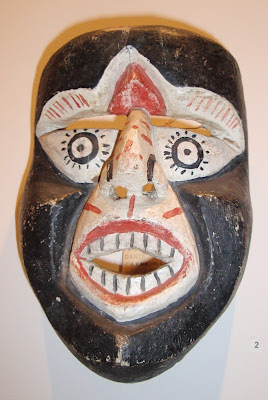It goes like this ...
In 1938, rightly fearing Hitler's horrendous plans for Jews, the family of the young teenager who was to become Ruth Lechuga was able to board a ship and escape to Mexico, eventually planning on relocating in the United States. After a short stay in Mexico, the ship sailed on to Ellis Island, only to find that America was letting no more Jews enter the country. Mexico agreed to take the immigrants in and provide them safety from the Nazi terrors.
This act created a life-long gratitude toward Mexico on the part of Ruth. All her life, she was fascinated by the beauty and depth of Mexican culture. She spent years traveling to all parts of Mexico collecting masks and other items that represented the history, the culture, indeed the spirit and soul of her adopted land. Eventually, she possessed more than 10,000 items in her collection, including more than 1,400 masks. .
 Early on, Ruth as she preferred to be called, received instruction in photography so she could more accurately account for her findings. "I'm not a great photographer," she once told her friend and anthropologist Marta Turok who helped her catalog her immense collection. "But it gives control and documentation to the objects that I have collected."
Early on, Ruth as she preferred to be called, received instruction in photography so she could more accurately account for her findings. "I'm not a great photographer," she once told her friend and anthropologist Marta Turok who helped her catalog her immense collection. "But it gives control and documentation to the objects that I have collected."Eventually, Ruth died, but Turok continued to work on the collection. "I looked at it as an anthropologist," Turok, who served as curator for the exhibit said in an opening-week talk at the Institute today. "Taken out of context and displayed just as art work they (the masks) are beautiful, of course. But when you work in the context about where they came from and what they mean for the people, they say so much more."
The masks, which are different for each of the regions of Mexico, have been employed in ceremonies since long before the Spanish conquered the land. "The masks were used to transmit stories to present and future generations," Turok explained, a function that still continues today. She showed slides of an early 21st Century festival which captured a masked replica of Osama bin Laden and a fireworks display depicting the destruction of the Twin Towers in New York City on Sept. 11, 2001.
Of all the various ceremonies that Mexicans enjoy that use masks, the Day of Dead is probably the most familiar. But there are ceremonies celebrating nature, religious beliefs, and historical events.
"And, of course, behind each mask is a mask maker," Turok said.
But Turok says she fears the centuries old tradition may be ending, a victim of changing times and dwindling resources. "It's a new crisis," Turok told the capacity crowd which packed the large hall at the institute to learn about the masks and their traditions. "Generations X and Y are into different things. And even the older people are urging the younger to leave and seek a better life. They say "do you want to live in this dire poverty? Don't become an artisan. Become something else.'"
Tales, Tidbits, and Tips
Cliches are cliches because they are true. They say a picture is worth a thousand words. So let's dispense with the words and look at some pictures taken by my mask-collecting wife Judy.






















No comments:
Post a Comment